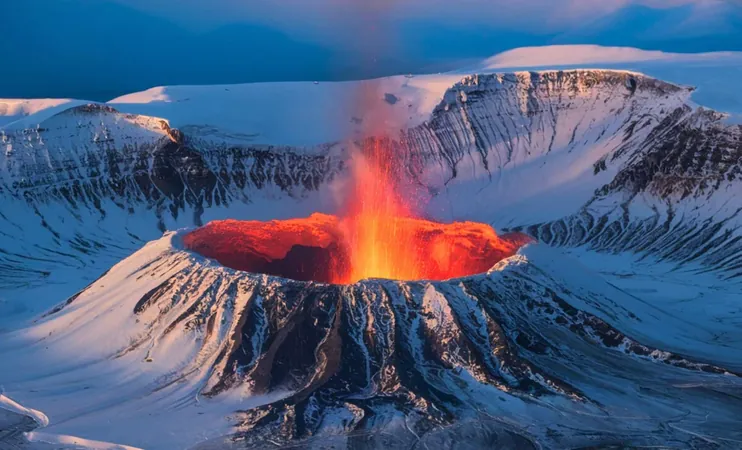
Unveiling Antarctica's Hidden Volcanoes: A Dire Warning for Our Planet’s Future
2025-01-09
Author: Jia
The Volcanic Underworld of Antarctica
Antarctica, typically perceived as an unchanging and lifeless landscape, is, in reality, a complex and dynamic environment. The West Antarctic Rift System, a volcanic hotspot, is home to over 100 volcanoes concealed beneath kilometers of ice. While Mount Erebus serves as a reminder of the region's volcanic activity, many of these volcanoes remain hidden, complicating efforts to study their behavior and predict potential eruptions.
These volcanoes are very much alive, and the buildup of pressure from the weight of the ice keeps them dormant. However, this fragile balance is becoming increasingly precarious due to climate change.
How Climate Change Fuels Eruptions
Recent research in the journal Geochemistry, Geophysics, Geosystems has illustrated a disturbing feedback loop initiated by the melting of Antarctic glaciers:
1. **Ice Thinning**: As the ice melts, the weight on the Earth's crust lessens, particularly over volcanic regions.
2. **Pressure Dynamics**: The reduced pressure allows the magma in these chambers to decompress, releasing trapped gases and creating expanding bubbles, which further increase internal pressure.
3. **Eruptions on the Horizon**: Eventually, the accumulated pressure forces magma up through the crust, resulting in eruptions beneath the ice.
These eruptions are far from inconsequential; they discharge substantial heat, which in turn accelerates ice melt, creating a self-reinforcing cycle that could persist for centuries.
The Ripple Effect: From Melting Ice to Global Chaos
The implications of this volcanic activity extend well beyond Antarctica’s icy shores:
- **Accelerated Ice Loss**: Volcanic heat leads to further ice melting, revealing bedrock that provides less insulation, making it easier for magma to surface.
- **Increased Greenhouse Gases**: Eruptions release carbon dioxide (CO2) and other gases that exacerbate climate change, increasing global temperatures even more.
If left unchecked, this cycle could result in Antarctica transforming into a center of volcanic activity, with dire consequences for the planet’s ecosystems and weather patterns.
A Looming Threat to Global Sea Levels
Antarctica’s rapidly melting ice sheets already pose a significant threat, potentially raising sea levels by several meters. The combined effects of volcanic activity could hasten the ice loss, particularly in vulnerable areas like West Antarctica, which is on the brink of collapse. Experts warn that:
- The West Antarctic Ice Sheet faces destabilization and collapse sooner than previously anticipated.
- Eruptions could inject ash and aerosols into the atmosphere, leading to significant alterations in global weather patterns and accelerating the warming of the Southern Ocean.
The consequences of this volcanic awakening touch every corner of the globe, jeopardizing coastal cities, delicate ecosystems, and existing weather systems.
Understanding the Implications for Humanity
One of the most unsettling aspects of this research is the possibility of a self-sustaining chain reaction that could continue even if human-induced greenhouse gas emissions halt. The mechanisms unleashed by ice melt and magma pressure might operate independently, leading to irreversible changes over centuries if current trends persist.
This situation highlights the intricate interconnectedness of Earth’s climate systems, emphasizing that disturbances in one region can trigger profound repercussions in others.
Looking Ahead: Mitigating the Impact of Hidden Volcanoes
While halting this volcanic chain reaction may be impossible, understanding the underlying mechanisms offers humanity a chance to prepare and respond. Monitoring the Antarctic ice sheet and its volcanic systems has never been more crucial. Utilizing advanced technologies—such as remote sensing, satellite imagery, and sophisticated simulations—could provide vital insights into predicting eruptions and minimizing their impacts.
The discovery of this hidden threat serves as a stark reminder: Antarctica is not just a passive victim of climate change; it could amplify its most severe consequences. As the climate crisis intensifies, it has become essential for global communities to remain vigilant and proactive in addressing these emerging threats.


 Brasil (PT)
Brasil (PT)
 Canada (EN)
Canada (EN)
 Chile (ES)
Chile (ES)
 Česko (CS)
Česko (CS)
 대한민국 (KO)
대한민국 (KO)
 España (ES)
España (ES)
 France (FR)
France (FR)
 Hong Kong (EN)
Hong Kong (EN)
 Italia (IT)
Italia (IT)
 日本 (JA)
日本 (JA)
 Magyarország (HU)
Magyarország (HU)
 Norge (NO)
Norge (NO)
 Polska (PL)
Polska (PL)
 Schweiz (DE)
Schweiz (DE)
 Singapore (EN)
Singapore (EN)
 Sverige (SV)
Sverige (SV)
 Suomi (FI)
Suomi (FI)
 Türkiye (TR)
Türkiye (TR)
 الإمارات العربية المتحدة (AR)
الإمارات العربية المتحدة (AR)